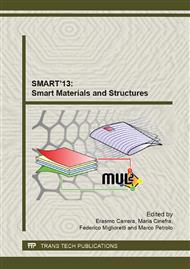[1]
E. J. French and M. F. Go. Treatment and chemoprevention of NSAID-associated gastrointestinal complications. Ther. Clin. Risk Manag. (2009) 65-73.
Google Scholar
[2]
I. C. West. Radicals and oxidative stress in diabetes. Diabetic Med. 17 (2000) 171-180.
Google Scholar
[3]
S. Lenzen. Oxidative stress: the vulnerable beta-cell. Biochem. Soc. Trans. 36 (2008) 343-347.
Google Scholar
[4]
A. Roessner, D. Kuester, P. Malfertheiner and R. Schneider-Stock. Oxidative stress in ulcerative colitis-associated carcinogenesis. Pathol. Res. Pract. 204 (2008) 511-524.
DOI: 10.1016/j.prp.2008.04.011
Google Scholar
[5]
H. Zhu and Y. R. Li. Oxidative stress and redox signaling mechanisms of inflammatory bowel disease: updated experimental and clinical evidence. Exp. Biol. Med. 237 (2012) 474-480.
DOI: 10.1258/ebm.2011.011358
Google Scholar
[6]
M. L. Block, L. Zecca and J. S. Hong. Microglia-mediated neurotoxicity: uncovering the molecular mechanisms. Nat. Rev. Neurosci. 8 (2007) 57-69.
DOI: 10.1038/nrn2038
Google Scholar
[7]
J. Y. Wang, L. L. Wen, Y. N. Huang, Y. T. Chen and M. C. Ku. Dual effects of antioxidants in neurodegeneration: Direct neuroprotection against oxidative stress and indirect protection via suppression of glia-mediated inflammation. Curr. Pharm. Des. 12 (2006) 3521-3533.
DOI: 10.2174/138161206778343109
Google Scholar
[8]
F. Bonomini, S. Tengattini, A. Fabiano, R. Bianchi and R. Rezzani. Atherosclerosis and oxidative stress. Histol. Histopath. 23 (2008) 381-390.
Google Scholar
[9]
R. M. Touyz and E. L. Schiffrin. Reactive oxygen species in vascular biology: implications in hypertension. Histochem. Cell Biol. 122 (2004) 339-352.
DOI: 10.1007/s00418-004-0696-7
Google Scholar
[10]
J. E. Klaunig and L. M. Kamendulis. The role of oxidative stress in carcinogenesis. Ann. Rev. Pharmacol. 44 (2004) 239-267.
DOI: 10.1146/annurev.pharmtox.44.101802.121851
Google Scholar
[11]
E. Lallana and N. Tirelli. Oxidation-Responsive Polymers: Which Groups to Use, How to Make Them, What to Expect From Them (Biomedical Applications). Macromol. Chem. Phys. 214 (2013) 143-158.
DOI: 10.1002/macp.201200502
Google Scholar
[12]
C. D. Vo, G. Kilcher and N. Tirelli. Polymers and Sulfur: what are Organic Polysulfides Good For? Preparative Strategies and Biological Applications. Macromol. Rapid Commun. 30 (2009) 299-315.
DOI: 10.1002/marc.200800740
Google Scholar
[13]
A. Napoli, M. Valentini, N. Tirelli, M. Muller and J. A. Hubbell. Oxidation-responsive polymeric vesicles. Nat. Mater. 3 (2004) 183-189.
DOI: 10.1038/nmat1081
Google Scholar
[14]
P. Hu and N. Tirelli. Inter-micellar dynamics in block copolymer micelles: FRET experiments of macroamphiphile and payload exchange. React. Funct. Polym. 71 (2011) 303-314.
DOI: 10.1016/j.reactfunctpolym.2010.10.010
Google Scholar
[15]
A. Rehor, J. A. Hubbell and N. Tirelli. Oxidation-sensitive polymeric nanoparticles. Langmuir 21 (2005) 411-417.
DOI: 10.1021/la0478043
Google Scholar
[16]
P. Hu and N. Tirelli. Scavenging ROS: Superoxide Dismutase/Catalase Mimetics by the Use of an Oxidation-Sensitive Nanocarrier/Enzyme Conjugate. Bioconjugate Chemistry 23 (2012) 438-449.
DOI: 10.1021/bc200449k
Google Scholar
[17]
P. Carampin, E. Lallana, J. Laliturai, S. C. Carroccio, C. Puglisi and N. Tirelli. Oxidant-Dependent REDOX Responsiveness of Polysulfides. Macromol. Chem. Phys. 213 (2012) 2052-2061.
DOI: 10.1002/macp.201200264
Google Scholar
[18]
V. V. Khutoryanskiy and N. Tirelli. Oxidation-responsiveness of nanomaterials for targeting inflammatory reactions. Pure Appl. Chem. 80 (2008) 1703-1718.
DOI: 10.1351/pac200880081703
Google Scholar
[19]
A. Rehor, N. E. Botterhuis, J. A. Hubbell, N. Sommerdijk and N. Tirelli. Glucose sensitivity through oxidation responsiveness. An example of cascade-responsive nano-sensors. J. Mater. Chem. 15 (2005) 4006-4009.
DOI: 10.1039/b510998a
Google Scholar


